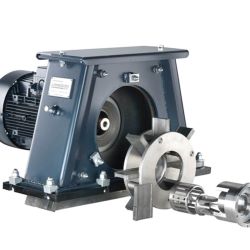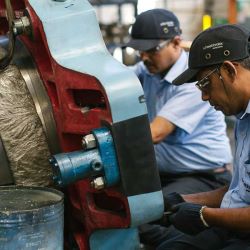In the wake of the devastating hurricanes Harvey, Irma and Maria in the Americas and other severe weather events around the world, businesses in affected areas are working hard to get their operations back up and running.
However, many are faced with severe water damage to their equipment. Wheelabrator has been helping them check and restore shot blast machines to ensure no further damage occurs through the premature use of affected equipment. We hope you’ll never be affected by a similar catastrophe, but if you encounter flooding in your facilities, here are a couple of essential tips from Tim Ogden, our Product Services Director in North America, on how to deal with water-damaged shot blast equipment.
What should users of shot blast equipment do if their machine has been exposed to flooding?
The best thing to do is to call the equipment manufacturer and get them in to assess the machine. Never run the machine without checks. Depending on where the waterline was, damage may not be serious and could be easy to fix – do not jeopardize this by running the machine prematurely. Any exposure to water can significantly affect electrics and auxiliary components, even where the core machine has not been reached by the water.
What are the biggest challenges when dealing with water-damaged blast equipment?
The most immediate challenge is the damage to the many electrical components – sensors, switches, conduits and the many motors on a blast machine. This of course applies to almost any type of industrial machinery.
The complication that is specific to blast machines is the behaviour of shot after exposure to water. Water binds together dust, broken down shot and abrasive into solid clumps that behave like cement and that can block and severely damage mechanical parts. These ‘reinforced concrete’ clumps are a problem at any point of the abrasive cycle. For example, bucket elevators and hoppers may be exposed to water at very low heights, particularly if the machine is installed in a pit. Even smaller clumps can jam up moving parts inside the machine and destroy internal components.
What can be done to get machines up and running again? And how long will it take?
We recommend a systematic assessment of the machine from the bottom up, including all electrical components and conduits, and to start removing water from them. Depending on the scale of the water damage and the height of the water line, it may be possible to carefully fan or air-dry parts in order to avoid having to replace them.
Then it’s on to the inner workings of the machine. Everything needs to be checked for clumps of abrasive that may get in the way of moving parts. This may involve flushing out shot residue inside the machine. It is important to extend this to all auxiliary equipment, like dust collectors and elevators, as these too can get damaged by solidified chunks of abrasive, if they are left in the machine.
With the range of equipment in the field and varying severity of damage, it is impossible to give an exact time frame for these measures. An initial assessment of a smaller machine could be done in less than a day, a more complex machine will take longer. But regardless of your type of equipment, the whole Wheelabrator team in your region will be on the road to get you and your peers back up and running again. Because we know that only then can the rebuild truly begin.
What else is there to bear in mind before switching blast equipment on again?
Consider any stored abrasive and whether it may have been affected by water. Unless the storage container is water tight, it is very likely that the shot has been spoilt in the same way as the shot inside the machine. It is usually safe to run it, if it can be poured and is free of clumps, so you may be able to sift it.
You usually don’t have to worry about losing your machine settings. If you have powered the facility down during evacuation, it may be possible to retrieve settings and programs. If not, OEMs like us usually keep a back-up copy of the original settings to ensure a quick restore.
Is there anything that can be done before an expected incident of flooding to “prepare” the machine for the water?
In cases like the recent flooding caused by Hurricanes Harvey and Irma, the most important thing is to follow evacuation procedures and ensure everybody gets out and into safety. Machines can be fixed and replaced, lost lives can’t.
The one thing we would recommend doing is already part of most evacuation drills for industrial facilities – to power down the entire facility to prevent danger to life.
So, in brief, if your machine has been flooded:
- Don’t run it without checks
- Call your Original Equipment Manufacturer
- Consider both damage to electricals AND the danger posed by clumped shot
- Don’t use stored abrasive without checks


